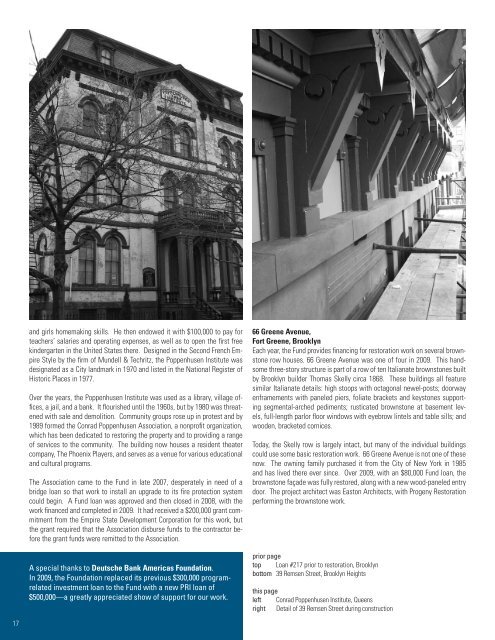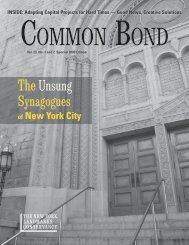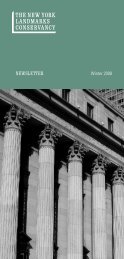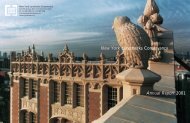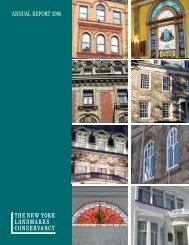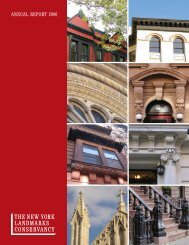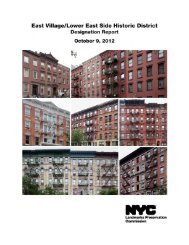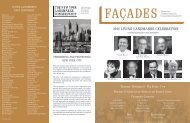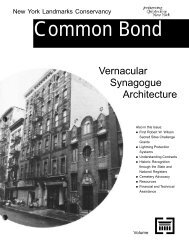Download Annual Report - The New York Landmarks Conservancy
Download Annual Report - The New York Landmarks Conservancy
Download Annual Report - The New York Landmarks Conservancy
You also want an ePaper? Increase the reach of your titles
YUMPU automatically turns print PDFs into web optimized ePapers that Google loves.
and girls homemaking skills. He then endowed it with $100,000 to pay forteachers’ salaries and operating expenses, as well as to open the first freekindergarten in the United States there. Designed in the Second French EmpireStyle by the firm of Mundell & Techritz, the Poppenhusen Institute wasdesignated as a City landmark in 1970 and listed in the National Register ofHistoric Places in 1977.Over the years, the Poppenhusen Institute was used as a library, village offices,a jail, and a bank. It flourished until the 1960s, but by 1980 was threatenedwith sale and demolition. Community groups rose up in protest and by1989 formed the Conrad Poppenhusen Association, a nonprofit organization,which has been dedicated to restoring the property and to providing a rangeof services to the community. <strong>The</strong> building now houses a resident theatercompany, <strong>The</strong> Phoenix Players, and serves as a venue for various educationaland cultural programs.<strong>The</strong> Association came to the Fund in late 2007, desperately in need of abridge loan so that work to install an upgrade to its fire protection systemcould begin. A Fund loan was approved and then closed in 2008, with thework financed and completed in 2009. It had received a $200,000 grant commitmentfrom the Empire State Development Corporation for this work, butthe grant required that the Association disburse funds to the contractor beforethe grant funds were remitted to the Association.A special thanks to Deutsche Bank Americas Foundation.In 2009, the Foundation replaced its previous $300,000 programrelatedinvestment loan to the Fund with a new PRI loan of$500,000—a greatly appreciated show of support for our work.66 Greene Avenue,Fort Greene, BrooklynEach year, the Fund provides financing for restoration work on several brownstonerow houses. 66 Greene Avenue was one of four in 2009. This handsomethree-story structure is part of a row of ten Italianate brownstones builtby Brooklyn builder Thomas Skelly circa 1868. <strong>The</strong>se buildings all featuresimilar Italianate details: high stoops with octagonal newel-posts; doorwayenframements with paneled piers, foliate brackets and keystones supportingsegmental-arched pediments; rusticated brownstone at basement levels,full-length parlor floor windows with eyebrow lintels and table sills; andwooden, bracketed cornices.Today, the Skelly row is largely intact, but many of the individual buildingscould use some basic restoration work. 66 Greene Avenue is not one of thesenow. <strong>The</strong> owning family purchased it from the City of <strong>New</strong> <strong>York</strong> in 1985and has lived there ever since. Over 2009, with an $80,000 Fund loan, thebrownstone façade was fully restored, along with a new wood-paneled entrydoor. <strong>The</strong> project architect was Easton Architects, with Progeny Restorationperforming the brownstone work.prior pagetop Loan #217 prior to restoration, Brooklynbottom 39 Remsen Street, Brooklyn Heightsthis pageleft Conrad Poppenhusen Institute, Queensright Detail of 39 Remsen Street during construction17


